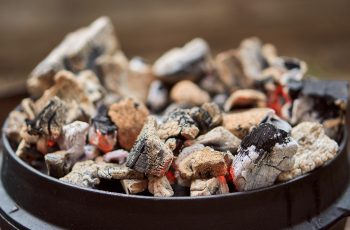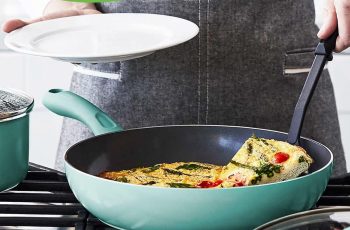Ad Blocker Detected
Our website is made possible by displaying online advertisements to our visitors. Please consider supporting us by disabling your ad blocker.
In today’s culinary world, where pressure cookers and instant pots have become the go-to tools for efficient cooking, it’s easy to overlook the humble saucepan. Yet, within its simple design lies a technique that has been perfected over centuries: simmering. In this article, you will explore the art of simmering in a saucepan, from understanding the ideal heat and temperature to learning the transformative power it holds over flavors and textures. Whether you’re a seasoned chef or just starting out in the kitchen, mastering the art of simmering will elevate your cooking skills to new heights and unlock a world of delicious possibilities.
Choosing the Right Saucepan
When it comes to simmering, choosing the right saucepan is crucial. The material of the saucepan can greatly affect the cooking process and the final result of your dish. Stainless steel saucepans are a popular choice due to their durability and even heat distribution. They are also easy to clean, making them a practical option for home cooks.
The size of the saucepan is another important consideration. Choosing a size that adequately fits the amount of ingredients you are working with is essential for successful simmering. A saucepan that is too small may result in overcrowding, which can lead to uneven cooking. On the other hand, a saucepan that is too large may cause the simmering liquid to evaporate too quickly.
Additionally, having a lid for your saucepan is crucial when simmering. The lid helps to trap heat and moisture, allowing the ingredients to cook evenly. It also helps to prevent evaporation and maintain the desired consistency of the simmering liquid. When choosing a saucepan, ensure that it comes with a well-fitting lid.
Preparing the Ingredients
Before you begin simmering, it is important to properly prepare your ingredients. Freshness is key when it comes to achieving optimal flavor and texture. Ensure that your vegetables, meats, and seafood are fresh and free from any spoilage. This will help to enhance the overall taste of your dish.
Chopping and slicing the ingredients appropriately is also crucial. Uniformity in size will ensure even cooking and prevent some pieces from being undercooked or overcooked. Take the time to properly chop your vegetables and slice your meats or seafood to achieve the best results.
If you are looking to infuse additional flavors into your dish, marinating your ingredients beforehand can be beneficial. This step involves soaking the ingredients in a mixture of herbs, spices, and liquids to enhance their flavor. Marinating can help tenderize meats, add depth to seafood, and infuse vegetables with delicious flavors.
Creating the Simmering Liquid
The simmering liquid forms the foundation of your dish, so it is important to choose the right components. One popular option is using broth or stock as the base. This not only adds flavor but also provides a rich and hearty liquid for your ingredients to simmer in. Vegetable, chicken, or beef broth can be used depending on the dish you are preparing.
Incorporating wine into your simmering liquid can elevate the flavors of your dish. Whether using white or red wine, it adds depth and complexity to the overall taste. The alcohol evaporates during cooking, leaving behind a delicious essence that enhances the flavors of the other ingredients.
Dairy products such as cream or milk can also be used to create a creamy and indulgent simmering liquid. This is particularly popular when making dishes like creamy soups or sauces. The dairy adds richness and a velvety texture to the dish, creating a comforting and satisfying experience.
Lastly, acidic ingredients like lemon juice or vinegar can be added to the simmering liquid to balance out flavors and enhance the overall taste. They can help brighten up the dish and add a refreshing touch to heavier ingredients. However, be cautious with the quantity of acidic ingredients used as too much can overpower the dish.
Bringing the Liquid to a Simmer
One of the critical steps in simmering is bringing the liquid to a simmering temperature. This temperature is lower than boiling and is indicated by small bubbles gently rising to the surface. It is important to be patient and gradually increase the heat to achieve the desired simmer.
When it comes to heating the liquid, you have the option of using a stovetop or an oven. Both methods have their advantages, and the choice depends on the specific dish you are preparing. Stovetop simmering allows for more control over the heat and is ideal for dishes that require frequent stirring or adjustments. Oven simmering, on the other hand, provides a more even and consistent heat distribution, making it suitable for larger quantities or longer cooking times.
Regardless of the method chosen, it is important to gradually heat the liquid. Starting with low or medium heat and incrementally increasing it allows the ingredients to cook evenly and prevents them from burning or sticking to the bottom. This gradual heating helps to develop flavors and maintain the desired consistency of the simmering liquid.
Simmering Techniques
When simmering, it is important to maintain a low heat setting throughout the cooking process. This gentle heat prevents the ingredients from overcooking and ensures that the flavors meld together. It is best to keep the heat low and consistent, adjusting it only when necessary.
Consistency is key when simmering, and that includes both the temperature and the stirring technique. Stirring the ingredients occasionally helps to distribute the heat evenly and prevent them from sticking to the bottom. However, excessive stirring can cause ingredients to break down or lose their texture. Find a balance and stir when necessary to maintain consistency.
Flavor Enhancement
To enhance the flavors of your dish, various aromatics can be added to the simmering liquid. These include onions, garlic, ginger, and shallots. They infuse the liquid with additional depth and complexity, creating a flavorful base for your ingredients.
Herbs and spices are another way to elevate the taste of your dish. From thyme and rosemary to cumin and turmeric, the options are endless. Experiment with different combinations to find the perfect balance of flavors that complement your ingredients.
Condiments and seasonings can also be used to further enhance the taste of your simmered dish. Soy sauce, Worcestershire sauce, and fish sauce are commonly used to add umami and depth to the flavors. Salt, pepper, and sugar can be used to balance and round out the taste profile.
Simmering Times
The simmering times vary depending on the type of ingredient you are cooking. Meats and poultry typically require a longer simmering time to ensure they are cooked through and tender. Seafood, on the other hand, cooks much faster and can become tough if overcooked. Vegetables and legumes have different cooking times depending on their size and texture.
To achieve optimal results, refer to specific recipes or cooking guides for the recommended simmering times of different ingredients. Keep in mind that undercooking can result in tough or uncooked food, while overcooking can lead to mushy textures and loss of flavor.
Troubleshooting Simmering
Sometimes, despite your best efforts, issues may arise during the simmering process. One common problem is a burned bottom, which can occur if the heat is too high or the liquid gets too low. To avoid this, make sure to stir the ingredients regularly and keep an eye on the heat level. Adding more liquid or adjusting the heat promptly can help prevent burning.
On the other hand, if your dish turns out too watery, it may be due to insufficient evaporation during simmering. Increasing the heat slightly and removing the lid can help evaporate the excess liquid and thicken the sauce. Alternatively, you can add a thickening agent such as cornstarch or flour, but be cautious not to overdo it, as it can affect the flavor and texture.
Overcooking is another issue that can arise during simmering. This can result in a loss of texture and flavor. To prevent overcooking, always keep an eye on the simmering times suggested for your specific ingredients. Regularly test the doneness to ensure you achieve the desired texture.
Simmering vs. Boiling
Simmering and boiling are two distinct cooking techniques, each with its own purpose and benefits. Simmering involves cooking at a lower temperature, resulting in gentle bubbles and a slow cooking process. This is ideal for tenderizing meats, allowing flavors to develop, and creating a rich and flavorful dish.
Boiling, on the other hand, involves cooking at a much higher temperature, resulting in vigorous bubbles and rapid cooking. This technique is commonly used for quickly cooking vegetables or boiling pasta. It is not suitable for dishes that require long cooking times or delicate ingredients.
Understanding the differences between simmering and boiling is crucial for choosing the right technique for your desired outcome.
Recipes to Master Simmering
To master the art of simmering, practicing with various recipes is essential. Here are three classic dishes that showcase the versatility and deliciousness of simmering:
-
Classic Chicken Soup: Simmer chicken pieces with aromatic vegetables, herbs, and broth for a comforting and nourishing soup. The simmering process allows the flavors to meld together and creates a flavorful broth that is perfect for a chilly day.
-
Bolognese Sauce: Simmer ground beef, onions, garlic, tomatoes, and a medley of herbs and spices to create a rich and hearty pasta sauce. The slow simmering helps to develop the layers of flavors and achieve a thick and luscious consistency.
-
Beef Stew: Simmer chunks of beef, root vegetables, and herbs in a savory broth for a comforting and filling stew. The low and slow simmering tenderizes the beef and infuses the vegetables with the delicious flavors of the broth.
By mastering these recipes, you will gain a solid foundation in the art of simmering and be well-equipped to create a variety of simmered dishes.
In conclusion, simmering is a culinary technique that requires attention to detail, patience, and practice. Choosing the right saucepan, preparing the ingredients properly, creating the simmering liquid, and maintaining the right temperature are all essential steps in achieving the desired results. With time and experience, you will become adept at simmering and be able to create flavorful and satisfying dishes that showcase the artistry of this cooking method.

